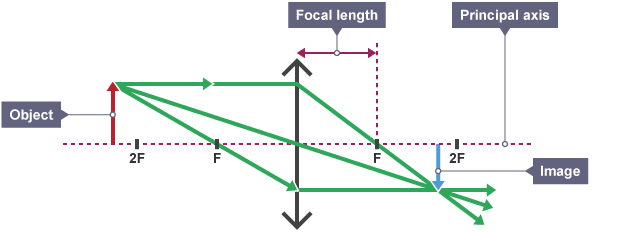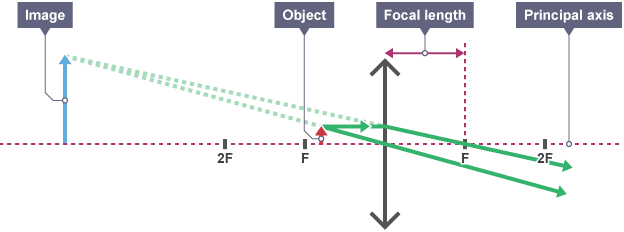
Images and Ray Diagrams
Lenses can produce real and virtual images
A real image is where the light from an object comes together to form an image on a screen-like the image formed on an eye’s retina
A virtual image is where the rays are diverging, so the light from the object appears to be coming from a completely different place
When you look in a mirror you see a virtual image of your face- because the object appears to be behind the mirror
You can get a virtual image when looking at an object through a magnifying lens-the virtual image looks bigger than the object actually is
To describe an image you need to say: how big it is compared to the object, whether it’s upright or inverted relative to the object, whether its real or virtual
Draw a ray diagram from an image through a convex lens
Pick a point on the top of the object. Draw a rau going from the object to the lens parallel to the axis of the lens
Draw another ray from the top of the object going right through the middle of the lens
The incident ray that’s parallel to the axis is refracted through the principal focus on the other side of the lens. Draw a refracted ray passing through the principal focus
The ray passing through the middle of the lens doesn’t bend
Mark where the rays meet. That’s the top of the image
Repeat the process for s point on the bottom of the object. When the bottom of the object is on the axis, the bottom of the image is also on the axis

Distance from the lens affects the image
An object at 2F will produce a real, inverted image the same size as the object, and at 2F
Between F and 2F it’ll make a real, inverted image bigger than the object, and beyond 2F
An object nearer than F will make a virtual image the right way up, bigger than the object, on the same side of the lens

Images and Ray Diagrams
Lenses can produce real and virtual images
A real image is where the light from an object comes together to form an image on a screen-like the image formed on an eye’s retina
A virtual image is where the rays are diverging, so the light from the object appears to be coming from a completely different place
When you look in a mirror you see a virtual image of your face- because the object appears to be behind the mirror
You can get a virtual image when looking at an object through a magnifying lens-the virtual image looks bigger than the object actually is
To describe an image you need to say: how big it is compared to the object, whether it’s upright or inverted relative to the object, whether its real or virtual
Draw a ray diagram from an image through a convex lens
Pick a point on the top of the object. Draw a rau going from the object to the lens parallel to the axis of the lens
Draw another ray from the top of the object going right through the middle of the lens
The incident ray that’s parallel to the axis is refracted through the principal focus on the other side of the lens. Draw a refracted ray passing through the principal focus
The ray passing through the middle of the lens doesn’t bend
Mark where the rays meet. That’s the top of the image
Repeat the process for s point on the bottom of the object. When the bottom of the object is on the axis, the bottom of the image is also on the axis

Distance from the lens affects the image
An object at 2F will produce a real, inverted image the same size as the object, and at 2F
Between F and 2F it’ll make a real, inverted image bigger than the object, and beyond 2F
An object nearer than F will make a virtual image the right way up, bigger than the object, on the same side of the lens

 Knowt
Knowt
